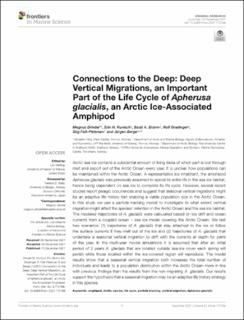| dc.contributor.author | Drivdal, Magnus | |
| dc.contributor.author | Kunisch, Erin | |
| dc.contributor.author | Bluhm, Bodil | |
| dc.contributor.author | Gradinger, Rolf | |
| dc.contributor.author | Falk-Petersen, Stig | |
| dc.contributor.author | Berge, Jørgen | |
| dc.date.accessioned | 2022-01-27T09:48:50Z | |
| dc.date.available | 2022-01-27T09:48:50Z | |
| dc.date.created | 2022-01-06T11:38:20Z | |
| dc.date.issued | 2021 | |
| dc.identifier.citation | Frontiers in Marine Science. 2021, 8, 1-14. | en_US |
| dc.identifier.issn | 2296-7745 | |
| dc.identifier.uri | https://hdl.handle.net/11250/2881249 | |
| dc.description.abstract | Arctic sea ice contains a substantial amount of living biota of which part is lost through melt and export out of the Arctic Ocean every year. It is unclear how populations can be maintained within the Arctic Ocean. A representative ice inhabitant, the amphipod Apherusa glacialis was previously assumed to spend its entire life in the sea ice habitat, hence being dependent on sea ice to complete its life cycle. However, several recent studies report pelagic occurrences and suggest that seasonal vertical migrations might be an adaptive life history trait enabling a viable population size in the Arctic Ocean. In this study we use a particle-tracking model to investigate to what extent vertical migration might affect the species’ retention in the Arctic Ocean and the sea ice habitat. The modeled trajectories of A. glacialis were calculated based on ice drift and ocean currents from a coupled ocean – sea ice model covering the Arctic Ocean. We test two scenarios: (1) trajectories of A. glacialis that stay attached to the ice or follow the surface currents if they melt out of the ice and (2) trajectories of A. glacialis that undertake a seasonal vertical migration to drift with the currents at depth for parts of the year. In the multi-year model simulations it is assumed that after an initial period of 2 years A. glacialis that are located outside sea-ice cover each spring will perish while those located within the ice-covered region will reproduce. The model results show that a seasonal vertical migration both increases the total number of individuals and leads to a population distribution within the Arctic Ocean more in line with previous findings than the results from the non-migrating A. glacialis. Our results support the hypothesis that a seasonal migration may be an adaptive life history strategy in this species. | en_US |
| dc.language.iso | eng | en_US |
| dc.publisher | Frontiers Media | en_US |
| dc.rights | Navngivelse 4.0 Internasjonal | * |
| dc.rights.uri | http://creativecommons.org/licenses/by/4.0/deed.no | * |
| dc.title | Connections to the Deep: Deep Vertical Migrations, an Important Part of the Life Cycle of Apherusa glacialis, an Arctic Ice-Associated Amphipod | en_US |
| dc.type | Peer reviewed | en_US |
| dc.type | Journal article | en_US |
| dc.description.version | publishedVersion | en_US |
| dc.rights.holder | Copyright: The Authors | en_US |
| dc.source.pagenumber | 1-14 | en_US |
| dc.source.volume | 8 | en_US |
| dc.source.journal | Frontiers in Marine Science | en_US |
| dc.identifier.doi | 10.3389/fmars.2021.772766 | |
| dc.identifier.cristin | 1975784 | |
| cristin.ispublished | true | |
| cristin.fulltext | original | |
| cristin.qualitycode | 1 | |

